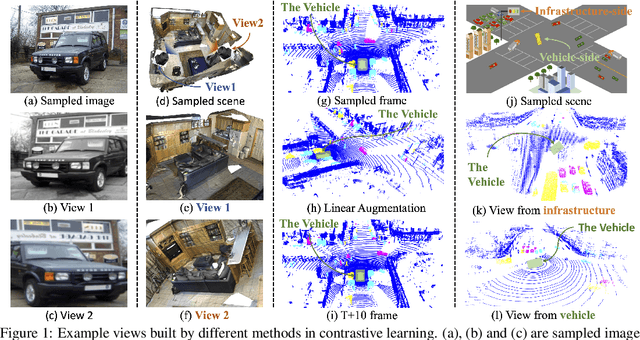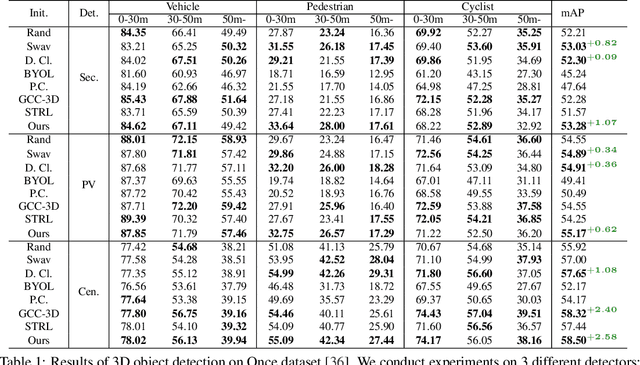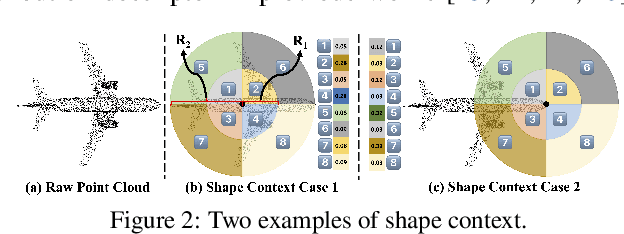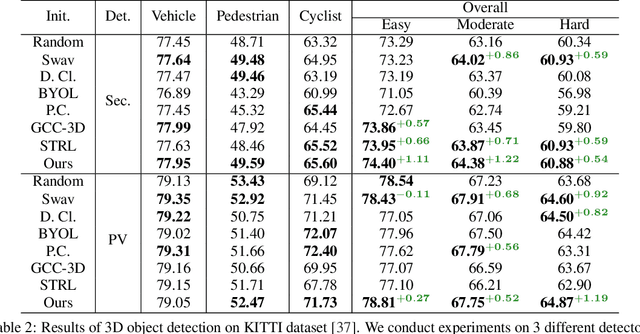Runsen Xu
VLM-Grounder: A VLM Agent for Zero-Shot 3D Visual Grounding
Oct 17, 2024Abstract:3D visual grounding is crucial for robots, requiring integration of natural language and 3D scene understanding. Traditional methods depending on supervised learning with 3D point clouds are limited by scarce datasets. Recently zero-shot methods leveraging LLMs have been proposed to address the data issue. While effective, these methods only use object-centric information, limiting their ability to handle complex queries. In this work, we present VLM-Grounder, a novel framework using vision-language models (VLMs) for zero-shot 3D visual grounding based solely on 2D images. VLM-Grounder dynamically stitches image sequences, employs a grounding and feedback scheme to find the target object, and uses a multi-view ensemble projection to accurately estimate 3D bounding boxes. Experiments on ScanRefer and Nr3D datasets show VLM-Grounder outperforms previous zero-shot methods, achieving 51.6% Acc@0.25 on ScanRefer and 48.0% Acc on Nr3D, without relying on 3D geometry or object priors. Codes are available at https://github.com/OpenRobotLab/VLM-Grounder .
MMScan: A Multi-Modal 3D Scene Dataset with Hierarchical Grounded Language Annotations
Jun 13, 2024



Abstract:With the emergence of LLMs and their integration with other data modalities, multi-modal 3D perception attracts more attention due to its connectivity to the physical world and makes rapid progress. However, limited by existing datasets, previous works mainly focus on understanding object properties or inter-object spatial relationships in a 3D scene. To tackle this problem, this paper builds the first largest ever multi-modal 3D scene dataset and benchmark with hierarchical grounded language annotations, MMScan. It is constructed based on a top-down logic, from region to object level, from a single target to inter-target relationships, covering holistic aspects of spatial and attribute understanding. The overall pipeline incorporates powerful VLMs via carefully designed prompts to initialize the annotations efficiently and further involve humans' correction in the loop to ensure the annotations are natural, correct, and comprehensive. Built upon existing 3D scanning data, the resulting multi-modal 3D dataset encompasses 1.4M meta-annotated captions on 109k objects and 7.7k regions as well as over 3.04M diverse samples for 3D visual grounding and question-answering benchmarks. We evaluate representative baselines on our benchmarks, analyze their capabilities in different aspects, and showcase the key problems to be addressed in the future. Furthermore, we use this high-quality dataset to train state-of-the-art 3D visual grounding and LLMs and obtain remarkable performance improvement both on existing benchmarks and in-the-wild evaluation. Codes, datasets, and benchmarks will be available at https://github.com/OpenRobotLab/EmbodiedScan.
Grounded 3D-LLM with Referent Tokens
May 16, 2024Abstract:Prior studies on 3D scene understanding have primarily developed specialized models for specific tasks or required task-specific fine-tuning. In this study, we propose Grounded 3D-LLM, which explores the potential of 3D large multi-modal models (3D LMMs) to consolidate various 3D vision tasks within a unified generative framework. The model uses scene referent tokens as special noun phrases to reference 3D scenes, enabling the handling of sequences that interleave 3D and textual data. It offers a natural approach for translating 3D vision tasks into language formats using task-specific instruction templates. To facilitate the use of referent tokens in subsequent language modeling, we have curated large-scale grounded language datasets that offer finer scene-text correspondence at the phrase level by bootstrapping existing object labels. Subsequently, we introduced Contrastive LAnguage-Scene Pre-training (CLASP) to effectively leverage this data, thereby integrating 3D vision with language models. Our comprehensive evaluation covers open-ended tasks like dense captioning and 3D QA, alongside close-ended tasks such as object detection and language grounding. Experiments across multiple 3D benchmarks reveal the leading performance and the broad applicability of Grounded 3D-LLM. Code and datasets will be released on the project page: https://groundedscenellm.github.io/grounded_3d-llm.github.io.
EmbodiedScan: A Holistic Multi-Modal 3D Perception Suite Towards Embodied AI
Dec 26, 2023Abstract:In the realm of computer vision and robotics, embodied agents are expected to explore their environment and carry out human instructions. This necessitates the ability to fully understand 3D scenes given their first-person observations and contextualize them into language for interaction. However, traditional research focuses more on scene-level input and output setups from a global view. To address the gap, we introduce EmbodiedScan, a multi-modal, ego-centric 3D perception dataset and benchmark for holistic 3D scene understanding. It encompasses over 5k scans encapsulating 1M ego-centric RGB-D views, 1M language prompts, 160k 3D-oriented boxes spanning over 760 categories, some of which partially align with LVIS, and dense semantic occupancy with 80 common categories. Building upon this database, we introduce a baseline framework named Embodied Perceptron. It is capable of processing an arbitrary number of multi-modal inputs and demonstrates remarkable 3D perception capabilities, both within the two series of benchmarks we set up, i.e., fundamental 3D perception tasks and language-grounded tasks, and in the wild. Codes, datasets, and benchmarks will be available at https://github.com/OpenRobotLab/EmbodiedScan.
PointLLM: Empowering Large Language Models to Understand Point Clouds
Aug 31, 2023Abstract:The unprecedented advancements in Large Language Models (LLMs) have created a profound impact on natural language processing but are yet to fully embrace the realm of 3D understanding. This paper introduces PointLLM, a preliminary effort to fill this gap, thereby enabling LLMs to understand point clouds and offering a new avenue beyond 2D visual data. PointLLM processes colored object point clouds with human instructions and generates contextually appropriate responses, illustrating its grasp of point clouds and common sense. Specifically, it leverages a point cloud encoder with a powerful LLM to effectively fuse geometric, appearance, and linguistic information. We collect a novel dataset comprising 660K simple and 70K complex point-text instruction pairs to enable a two-stage training strategy: initially aligning latent spaces and subsequently instruction-tuning the unified model. To rigorously evaluate our model's perceptual abilities and its generalization capabilities, we establish two benchmarks: Generative 3D Object Classification and 3D Object Captioning, assessed through three different methods, including human evaluation, GPT-4/ChatGPT evaluation, and traditional metrics. Experiment results show that PointLLM demonstrates superior performance over existing 2D baselines. Remarkably, in human-evaluated object captioning tasks, PointLLM outperforms human annotators in over 50% of the samples. Codes, datasets, and benchmarks are available at https://github.com/OpenRobotLab/PointLLM .
Fine-Grained Cross-View Geo-Localization Using a Correlation-Aware Homography Estimator
Aug 31, 2023Abstract:In this paper, we introduce a novel approach to fine-grained cross-view geo-localization. Our method aligns a warped ground image with a corresponding GPS-tagged satellite image covering the same area using homography estimation. We first employ a differentiable spherical transform, adhering to geometric principles, to accurately align the perspective of the ground image with the satellite map. This transformation effectively places ground and aerial images in the same view and on the same plane, reducing the task to an image alignment problem. To address challenges such as occlusion, small overlapping range, and seasonal variations, we propose a robust correlation-aware homography estimator to align similar parts of the transformed ground image with the satellite image. Our method achieves sub-pixel resolution and meter-level GPS accuracy by mapping the center point of the transformed ground image to the satellite image using a homography matrix and determining the orientation of the ground camera using a point above the central axis. Operating at a speed of 30 FPS, our method outperforms state-of-the-art techniques, reducing the mean metric localization error by 21.3% and 32.4% in same-area and cross-area generalization tasks on the VIGOR benchmark, respectively, and by 34.4% on the KITTI benchmark in same-area evaluation.
MV-JAR: Masked Voxel Jigsaw and Reconstruction for LiDAR-Based Self-Supervised Pre-Training
Mar 23, 2023



Abstract:This paper introduces the Masked Voxel Jigsaw and Reconstruction (MV-JAR) method for LiDAR-based self-supervised pre-training and a carefully designed data-efficient 3D object detection benchmark on the Waymo dataset. Inspired by the scene-voxel-point hierarchy in downstream 3D object detectors, we design masking and reconstruction strategies accounting for voxel distributions in the scene and local point distributions within the voxel. We employ a Reversed-Furthest-Voxel-Sampling strategy to address the uneven distribution of LiDAR points and propose MV-JAR, which combines two techniques for modeling the aforementioned distributions, resulting in superior performance. Our experiments reveal limitations in previous data-efficient experiments, which uniformly sample fine-tuning splits with varying data proportions from each LiDAR sequence, leading to similar data diversity across splits. To address this, we propose a new benchmark that samples scene sequences for diverse fine-tuning splits, ensuring adequate model convergence and providing a more accurate evaluation of pre-training methods. Experiments on our Waymo benchmark and the KITTI dataset demonstrate that MV-JAR consistently and significantly improves 3D detection performance across various data scales, achieving up to a 6.3% increase in mAPH compared to training from scratch. Codes and the benchmark will be available at https://github.com/SmartBot-PJLab/MV-JAR .
CO^3: Cooperative Unsupervised 3D Representation Learning for Autonomous Driving
Jun 08, 2022



Abstract:Unsupervised contrastive learning for indoor-scene point clouds has achieved great successes. However, unsupervised learning point clouds in outdoor scenes remains challenging because previous methods need to reconstruct the whole scene and capture partial views for the contrastive objective. This is infeasible in outdoor scenes with moving objects, obstacles, and sensors. In this paper, we propose CO^3, namely Cooperative Contrastive Learning and Contextual Shape Prediction, to learn 3D representation for outdoor-scene point clouds in an unsupervised manner. CO^3 has several merits compared to existing methods. (1) It utilizes LiDAR point clouds from vehicle-side and infrastructure-side to build views that differ enough but meanwhile maintain common semantic information for contrastive learning, which are more appropriate than views built by previous methods. (2) Alongside the contrastive objective, shape context prediction is proposed as pre-training goal and brings more task-relevant information for unsupervised 3D point cloud representation learning, which are beneficial when transferring the learned representation to downstream detection tasks. (3) As compared to previous methods, representation learned by CO^3 is able to be transferred to different outdoor scene dataset collected by different type of LiDAR sensors. (4) CO^3 improves current state-of-the-art methods on both Once and KITTI datasets by up to 2.58 mAP. Codes and models will be released. We believe CO^3 will facilitate understanding LiDAR point clouds in outdoor scene.
LIFE: Lighting Invariant Flow Estimation
Apr 19, 2021



Abstract:We tackle the problem of estimating flow between two images with large lighting variations. Recent learning-based flow estimation frameworks have shown remarkable performance on image pairs with small displacement and constant illuminations, but cannot work well on cases with large viewpoint change and lighting variations because of the lack of pixel-wise flow annotations for such cases. We observe that via the Structure-from-Motion (SfM) techniques, one can easily estimate relative camera poses between image pairs with large viewpoint change and lighting variations. We propose a novel weakly supervised framework LIFE to train a neural network for estimating accurate lighting-invariant flows between image pairs. Sparse correspondences are conventionally established via feature matching with descriptors encoding local image contents. However, local image contents are inevitably ambiguous and error-prone during the cross-image feature matching process, which hinders downstream tasks. We propose to guide feature matching with the flows predicted by LIFE, which addresses the ambiguous matching by utilizing abundant context information in the image pairs. We show that LIFE outperforms previous flow learning frameworks by large margins in challenging scenarios, consistently improves feature matching, and benefits downstream tasks.
 Add to Chrome
Add to Chrome Add to Firefox
Add to Firefox Add to Edge
Add to Edge